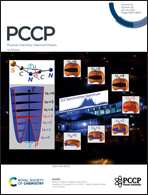Effects of semicore electrons on stopping power in helium-irradiated aluminum nanosheets†
Abstract
The stopping power of energetic He ions traversing an Al film is studied by combining the time-dependent density-functional theory method with molecular dynamics simulations. We investigated the dependence of the semicore electron excitation of the Al film on the projectile's trajectory and its charge state. Our results show that for the off-channeling trajectories the semicore electrons contribute significantly to the stopping power of the Al film as the He+ ion velocity exceeds 1.0 a.u, and in contrast, it is negligible for the channeling trajectories. Most importantly, we found two unexpected effects of semicore electrons on the stopping power in helium-irradiated aluminum nanosheets, i.e., (1) the semicore electrons can contribute to the energy loss for both high and low energy projectiles under the off-channeling trajectory; (2) as the projectile velocity increases from 0.4 a.u. to 2.0 a.u. although semicore electron excitation (including transition in the target, ionization away from the target and transfer to the projectile ion) of the target atom is gradually inhibited, the influence of semicore electrons on valence electron excitation is gradually enhanced. Our finding allows us to gain new insights into the stopping of ions in metals.



 Please wait while we load your content...
Please wait while we load your content...